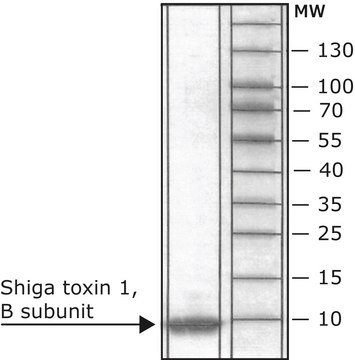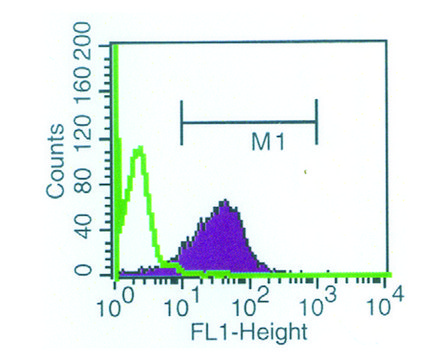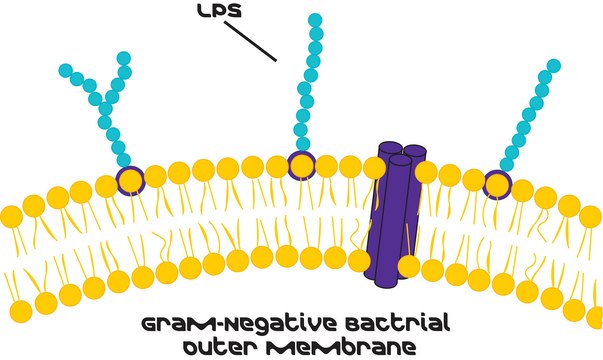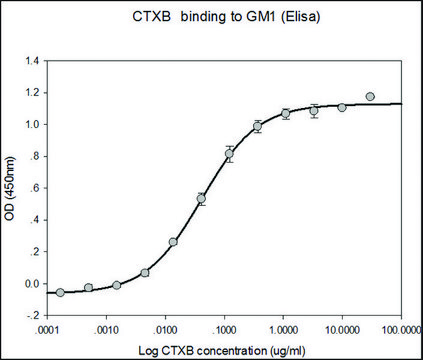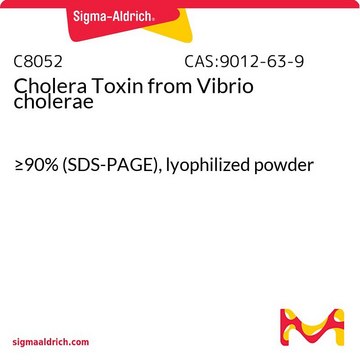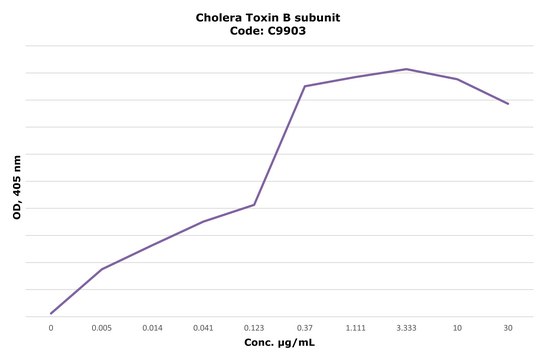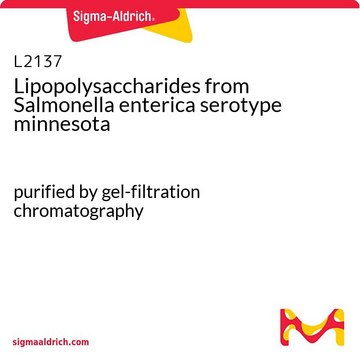推荐产品
生化/生理作用
The Shiga toxins are a family of related protein toxins secreted by certain types of bacteria.
The Shiga toxins are a family of related protein toxins secreted by certain types of bacteria. Shiga toxin (Stx) is produced by Shigella dysenteriae; whereas, the Shiga-like toxins, Stx1 and Stx2, with a few known isoforms, are secreted by specific strains of Escherichia coli named Shiga-toxin-producing E. coli (STEC), such as E. coli O157:H7, which causes bloody diarrhea and hemorrhagic colitis in humans, sometimes resulting in fatal systemic complications.
Stx1 is identical to Stx, while the Stx2 isoforms share less sequence similarity with Stx (∼60%) and are immunologically distinct. In spite of the differences in their amino acid sequence, all Stx isoforms share the same overall toxin structure and mechanism of action.
Shiga toxins consists of two polypeptides. An A chain and a B chain non-covalently associate with an apparent stoichiometry of one A and five B chains to form the holotoxin. The catalytic A subunit has
RNA N-glycosidase activity that inhibits eukaryotic protein synthesis. The B subunits form a pentamer, which recognizes and binds to the functional cell-surface receptor globotriaosylceramide [Gb3; Gala(1-4)-Galb(1-4)-Glcb1-ceramide]. Gb3 is overexpressed in membranes of numerous tumor cells, therefore STxB binding to Gb3 receptors may be useful for cell-specific vectorization, labeling, and imaging purposes.
Stx1 is identical to Stx, while the Stx2 isoforms share less sequence similarity with Stx (∼60%) and are immunologically distinct. In spite of the differences in their amino acid sequence, all Stx isoforms share the same overall toxin structure and mechanism of action.
Shiga toxins consists of two polypeptides. An A chain and a B chain non-covalently associate with an apparent stoichiometry of one A and five B chains to form the holotoxin. The catalytic A subunit has
RNA N-glycosidase activity that inhibits eukaryotic protein synthesis. The B subunits form a pentamer, which recognizes and binds to the functional cell-surface receptor globotriaosylceramide [Gb3; Gala(1-4)-Galb(1-4)-Glcb1-ceramide]. Gb3 is overexpressed in membranes of numerous tumor cells, therefore STxB binding to Gb3 receptors may be useful for cell-specific vectorization, labeling, and imaging purposes.
外形
The product is a recombinant Shiga toxin B subunit, which contains 69 amino acid residues and a HIS-tag at the C-terminus. It is lyophilized from 0.2 μm filtered solution of phosphate buffer without any carrier protein.
制备说明
Reconstitute the contents of the vial using water to a concentration of 0.1-1.0 mg/mL. This solution can then be diluted into other aqueous buffers and stored at 2-8 °C for up to 4 months or at -20 °C for extended use.
分析说明
Gb3 Binding activity: significant binding above background is achieved with ≤1 μg/mL of STxB. The activity of STxB is measured by its ability to bind to Gb3, which requires its pentameric form.
警示用语:
Warning
预防措施声明
危险分类
Acute Tox. 4 Dermal - Acute Tox. 4 Inhalation - Acute Tox. 4 Oral
储存分类代码
11 - Combustible Solids
WGK
WGK 3
闪点(°F)
Not applicable
闪点(°C)
Not applicable
法规信息
新产品
In-Sun Shin et al.
Chemical & pharmaceutical bulletin, 54(4), 522-527 (2006-04-06)
A two-step binding assay for globotriaosylceramide (Gb3) content was developed by histidine-tagging strategy, which is a well-established method for the purification of recombinant proteins. The complete binding of the recombinant His-tagged Shiga toxin 1B subunit (1B-His) (1 microg/ml) to the
Xihua Yue et al.
BMC biology, 19(1), 194-194 (2021-09-09)
KDEL receptor helps establish cellular equilibrium in the early secretory pathway by recycling leaked ER-chaperones to the ER during secretion of newly synthesized proteins. Studies have also shown that KDEL receptor may function as a signaling protein that orchestrates membrane
我们的科学家团队拥有各种研究领域经验,包括生命科学、材料科学、化学合成、色谱、分析及许多其他领域.
联系技术服务部门